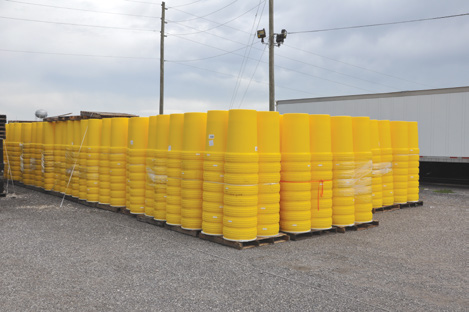Sun Orchard Case Study
This story will share the experience of one beverage manufacturer and its efforts to leverage sustainability opportunities in intermediate packaging; not only in the pursuit of operational efficiencies and financial gain, but also in the pursuit of becoming a role model for responsible environmental stewardship.
“Sun Orchard is a full-service manufacturer of premium juices, fruit-based beverages, and delicious bar mixers. With production facilities in Arizona and Florida, our wide variety of products are delivered coast-to-coast throughout the US and Canada at least once a week to restaurants, bars, and hotels known for the high quality of their food and beverages. We like to call ourselves “America’s Independent Micro-Juicery” because we also excel at developing customized juice and beverage solutions for foodservice and retail customers under private labels as well as the Sun Orchard brand name. After more than 25 years in the foodservice industry, we continue to pride ourselves on superior quality and taste, innovative R&D, and personalized customer service.”
The food and beverage industry depends heavily on steel drums to ship ingredients from their many suppliers. It is estimated1 that the active float of steel drums are those manufactured since 2003 and consist of approximately 142 million tight head drums and another 54 million open head drums. Plastic drums are only a fraction of the steel float and are estimated to be anywhere from 10 to 15 million drums. Clearly the steel drum is the current workhorse for food and beverage companies.
Sun Orchard calls itself “America’s Independent Micro-Juicery” because of its unique ability to produce customized juices and beverages at a large scale, and because it utilizes a “batch-by-batch, made-to-order” manufacturing process so that the juice products it creates maintain their premium flavor and nutritional value. The 55-gallon drums are a key component of this process. During the harvest season, Sun Orchard squeezes and gently pasteurizes a portion of its citrus juices into drums, which then go to frozen storage. Throughout the year, Sun Orchard then blends the frozen juices to create a wide variety of juices, beverages and bar mixers for its vast array of customers.
There are two common drum float options for beverage processors: 1) Utilize a 3rd party vendor to manage the drum float, which is usually made up entirely of steel drums; or 2) Own and maintain a float of drums, which can be steel, plastic, or both. The first option is depicted on the top of the drawing in Figure 2. Sun Orchard chooses to own the float of drums and maintain the inventory on site as shown on the bottom of Figure 2.


On the surface these differences seem subtle until you examine the options more closely. By owning their own float Sun Orchard eliminates a 3rd party provider and some significant logistical complexity. A typical truckload consists of only 200 drums so moving drums between the operation and a 3rd party requires some planning, trucks and time. Sun Orchard understands that once a drum float is in place it becomes an investment that is utilized strictly for the operation that owns it and when managed properly the drum inventory can turn over more than once per year. When a company chooses instead a 3rd party drum provider the company locks into a 1X inventory turn and subjects itself to potential price increases and questions of drum availability.
In the pursuit of operational efficiency, Sun Orchard did not stop with just owning a float of drums; they have begun testing a new kind of drum. They searched for a drum that would provide them the efficiencies that they required and they found it in a plastic drum, the N55 from COEXCELL http://www.coexcellinc.com. The drum has slightly tapered sidewalls allowing it to nest with other drums like paper cups. The ability to stack allows the plastic drum to be stored utilizing less space improving warehouse space efficiency by up to 75%. Nestability also has a significant impact on space utilization in the processing rooms where work-space availability can often be an issue; and provides for a very safe storing configuration within the busy processing areas.
Since the plastic drum weighs about half the weight of the steel drum it is easier to lift. Additionally, since the plastic drums nest together, 736 empty drums with bands and lids can be shipped in a trailer whereas only about 200 steel drums can be shipped in the same trailer and this results in transportation savings as well.
The N55 plastic drum from COEXCELL is made with high quality resins giving the drum characteristics of long life and additional tolerance when exposed to the elements. The smooth plastic interior makes it very easy for an operator to inspect the drum for foreign materials prior to filling. The plastic drum does not require refurbishing during its life whereas steel drums are often refurbished a number of times. Perhaps Boyd Beasley described it best when speaking about cleaning and maintenance, “Plastic drums are simply not a problem. You wipe them down and they look like new. Our experience is that they might just last forever. We expect somewhere around 12 to 14 years.”
In early 2010 Sun Orchard’s supplier of plastic drums, COEXCELL contracted with Global Environment and Technology Foundation, a nonprofit in Arlington, VA to study and report on the environmental impact of the N55 plastic drum system versus the steel drum.
In terms of environmental impact, the N55 plastic drum system is clearly advantaged when compared to 55 gallon steel drums/wooden pallet combination. The environmental investigation compared the two packages by looking at materials, energy and water used and by investigating CO2 and wastes that are emitted during the life cycles of each. On each and every score, the N55 plastic drum system was substantially superior. Figure 3 below graphically depicts the comparison of each package in the various dimensions of the analysis. Although the global definitions and metrics of sustainable packaging were in considerable flux at the time that the report was written, these findings are sufficiently significant that it is clear that the N55 plastic drum will be superior to the steel drum with respect to environmental sustainability regardless of how the standards and metrics evolve over time.
The report concluded that the plastic drum is advantaged through reductions in raw materials used, energy and water used, CO2 emitted and solid waste produced. Plastic drums are advantaged through energy required for reconditioning and transportation. The N55 plastic drum is advantaged because very little reconditioning is required whereas there is a limit to the number of times a steel drum can be reconditioned. The recycling of plastic uses less energy than the recycling of steel. A high quality plastic drum such as the N55 does not require painting, which avoids volatile organic compounds going into the environment. The study also found that the N55 plastic drum met most criteria of Sustainable Packaging Coalition.


When Sun Orchard had the opportunity to review the environmental results of the plastic drum, they were pleased but not surprised. For Sun Orchard the environmental study just confirmed what they had experienced many times before. When they stay on the path of improving efficiency, then it is not unusual that the final result improves everything – operational, environmental and financial results.